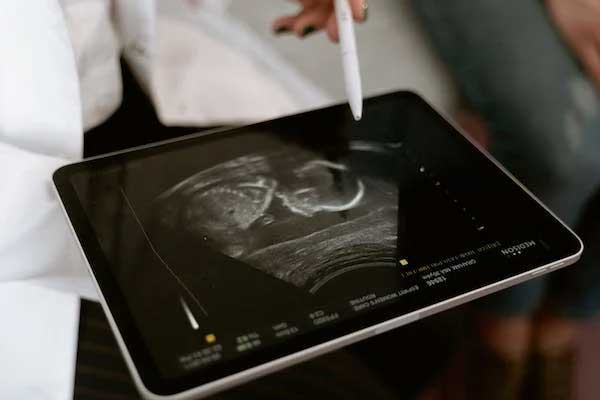If you expect a bundle of joy, reaching the 13-week mark is a major milestone. This period is often filled with anticipation and excitement as it’s time for an important prenatal check-up — the second-trimester ultrasound. An ultrasound at this stage is crucial as it gives you and your healthcare provider a glimpse into your baby’s development and health.
When you reach the 13-week mark in your pregnancy, it’s time for the ultrasound you’ve been waiting for. It’s a look inside to see how your baby’s doing. This peek inside does a lot—it checks how your baby is growing if you might have more than one, and it helps countdown the days until you meet.
Plus, it also tells the doctor that everything is going smoothly. Think of this ultrasound as your sneak preview and reassurance that your pregnancy is on track. It’s a simple, safe way to know that your little one is doing fine.
What Does the Second Trimester Mean
The second trimester marks significant progress in your pregnancy journey, typically from week 13 to week 26. During this phase, many expectant mothers notice decreased early pregnancy symptoms and a renewed sense of energy.
This trimester is often a time of rapid growth and development for your baby and an exciting period for parents-to-be as they get closer to meeting their little one. Detailed views of your baby through ultrasound scans, offered by the best maternity services, create opportunities to bond and cherish the first images of your child.
During these pivotal weeks, your baby’s organs and structures become more defined and begin to function, with the fetus growing more vigorous and active. You might start feeling the first delightful flutters of baby movement as your little one kicks and stretches.
The second trimester also offers detailed views of your baby through ultrasound scans, creating opportunities to bond and cherish the first images of your child.
For mothers, this middle phase provides a bit of respite from the rollercoaster of the first trimester, and it’s before the final stretch that the physical demand of pregnancy becomes more pronounced.
It’s an essential time for making decisions about prenatal care, considering childbirth education classes, and discussing any concerns or plans for the third trimester and delivery with your healthcare provider.
In short, the second trimester is a phase of growth, anticipation, and preparation, offering expectant parents the chance to enjoy the pregnancy and plan for the future.
The Purpose of the 13-Week Ultrasound
At 13 weeks, an ultrasound can give you a clearer picture of your baby’s growth. It is typically performed to:
Identifying Multiple Pregnancies
The ultrasound reveals if you’re carrying more than one baby. Spotting twins, triplets, or more at this stage allows for better monitoring and preparation for a healthy pregnancy journey with multiples.
Monitoring Baby’s Developmental Progress
During the scan, technicians measure your baby’s growth. This includes checking the fetal heartbeat, limb length, and other critical developmental milestones to ensure your baby grows as expected.
Refining Your Due Date
Your estimated due date, initially calculated from your last menstrual period, becomes more accurate following this scan. Precise measurements of the baby help narrow down the expected delivery window, aiding in planning for the arrival.
Examining the Placenta, Umbilical Cord, and Amniotic Fluid
The health condition of the umbilical cord and placenta are vital, as they provide your baby with nutrients and oxygen. The ultrasound checks these structures to ensure they function correctly. It also evaluates amniotic fluid levels, essential for a baby’s cushioning and movement.
Searching for Anatomical Anomalies
At this stage, the technician looks closely at your baby’s anatomy for any irregularities. Early detection of anatomical differences can lead to better management and outcomes for potential conditions.
Each of these aspects of the 13-week ultrasound is instrumental in paving the way for your ongoing pregnancy care, giving you peace of mind and helping ensure your and your baby’s well-being.
Preparing for Your Ultrasound
Before your appointment at the pregnancy care center, follow any guidelines provided by your healthcare provider. Generally, you may be asked to come with a full bladder to help improve the clarity of the ultrasound images.
During the Ultrasound
You’ll be settled onto an exam table, and a special gel will be applied to your abdomen. The sonographer will move a transducer across your stomach, sending images of your baby to a monitor. It’s a painless procedure that usually lasts between 15 to 30 minutes.
Viewing Your Baby
One of the most exciting parts of the 13-week ultrasound is seeing your baby in more detail. You’ll be able to make out their tiny hands and feet and sometimes even catch them in the act of sucking a thumb or wriggling around!
Health Checks
The sonographer will measure parts of your baby’s body to ensure everything is developing as it should be. They may also check for specific early markers of chromosomal abnormalities, though detailed screenings typically occur later.
After the Ultrasound
Once the ultrasound is complete, your healthcare provider will discuss the findings with you. This is a great time to ask any questions about your pregnancy.
What Are the Benefits of a 13-Week Pregnancy Ultrasound
At your 13-week pregnancy ultrasound, there’s a checklist of things the doctor or specialist will look through:
- Baby’s Size: The ultrasound measures your baby from head to bottom – this measurement is known as the crown-rump length. It’s a vital part of the scan because it can help pinpoint how far along you are in your pregnancy and solidify your due date. It’s an exciting moment to understand how big your little one is!
- Kidneys and Bladder: Development doesn’t skip a beat in the womb – your baby’s kidneys are already at work, processing fluid, and their tiny bladder can fill and empty. This impressive function is an excellent sign that your baby’s urinary tract is progressing.
- Bones: As you peer into the ultrasound screen, you’ll see more defined bones, particularly in the arms and legs. These images reveal the continuous growth and how your baby’s limbs form in more detail, which is reassuring and quite extraordinary.
- Baby’s Sex: Even though it’s still early, the ultrasound may start to show the external development of your baby’s sex organs. It’s a first look at whether you might have a boy or a girl, although it may not be 100% clear at this stage.
- Body Proportions: Your ultrasound will show that your baby’s body is starting to catch up with the growth of its head. This change in proportion is essential as it indicates healthy development and showcases the distinct human form emerging.
- Body Shape: Attention is given to your baby’s overall shape and structure. The technician will look at the baby’s anatomy to ensure everything appears as it should, providing confidence that your baby’s growth is on the right path.
- Wiggles: Babies start to move quite early, and by 13 weeks, those movements might be visible during the ultrasound. It’s a joy to possibly catch a glimpse of your little one kicking or waving their tiny arms!
- Heart: A crucial part of the check is listening to the fetal heartbeat and observing the blood flow. This part of the scan ensures that your baby’s heart rate is healthy and their circulatory system is developing well.
- Amniotic Fluid: The right amount of amniotic fluid is imperative; it’s like a cushion for your baby and helps with development. The ultrasound can reveal how much fluid is present, giving you peace of mind that your baby’s environment is safe.
- Placenta: This organ is your baby’s lifeline, delivering nutrients and oxygen and removing waste. The scan assesses the placenta’s health and placement in the uterus to confirm it supports your baby as needed.
- Cervix, Ovaries, and Uterus: These parts play a supporting role during pregnancy and are preparatory for your delivery day. The technician will look at the length and condition of your cervix, the state of the ovaries, and whether the uterus is adapting well to the pregnancy.
- Vaginal Bleeding: If you’ve been experiencing any bleeding, the ultrasound can often identify the cause, relieving anxiety and ensuring any issues are managed promptly and effectively.
Didn’t get scanned at 11 or 12 weeks? No problem. They can still confirm your due date and look for twins (or more!). Plus, they measure the fluid at the back of the baby’s neck to gauge any risk for chromosomal differences.
Finding the Right Care in Atlanta
Tackling on the journey of motherhood is an incredible and, at times, an overwhelming experience. Ensuring you have the proper support and care is paramount. For those looking for compassionate, skilled, and attentive maternal care, obgyn is a noteworthy consideration.
Whether you’re coming in for your first gynecological exam, a prenatal appointment, or even a menopause consultation, Atlanta Obstetrics and Gynecology Specialists have a proven track record of being honored as a Top Doctor consecutively.
Meet our experts, including Dr. Yvette M. Smith, Dr. Juanita Wyatt Hathaway, Dr. Valerie Leah Johnson, Dr. Sarah Jeffers, and Dr. Tressa Levenson. They are here to provide you with the best possible health outcomes throughout every stage of your life with kindness and expertise.
Expecting parents can feel assured that by choosing obgyn Atlanta, they are partnering with a dedicated team that offers routine care and advanced procedures. You are not just another patient to us; you’re part of the family we help keep healthy and happy throughout your life’s journey.

